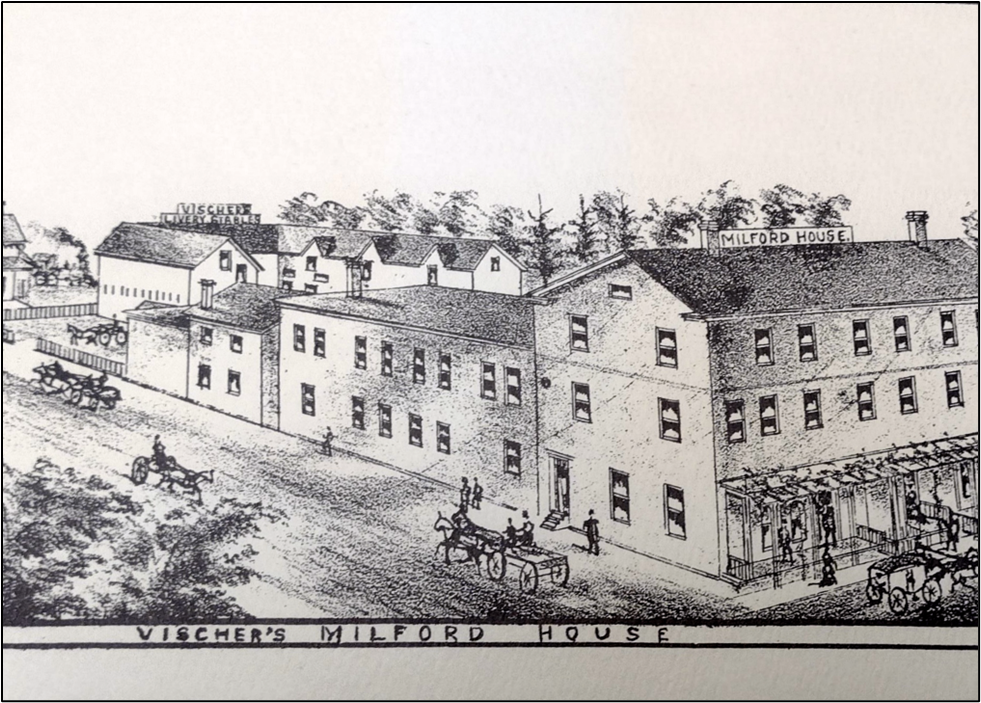By Marilyn May
Milford History

This drawing of the Milford House and Vischer’s Stables is from an 1882 engraving by the O.H. Bailey & Co. of Boston. Oakley Hoopes Bailey (1843–1947) was known for producing panoramic, bird’s-eye views. The eastbound railway station is at the far left of this picture. Photo courtesy of the Daniel E. Moger photo collection.
Depot Street, one of the shortest streets in Milford center, runs off North Broad between the Milford Bank parking lot and the Masonic Lodge built in 1878.
Over the years on this street, you could rent a horse and carriage, stable your own horse, get lodging and a meal for the night, attend a Daughters of the American Republic meeting, learn the Cub Scout way to tie knots, join the lady volunteers of the Red Cross making cancer dressings, or do your banking.
There were times when you could also select a roast for Sunday dinner, buy insurance for your house or attend a meeting of the Masons – if you knew the secret signs to get you past the front door.
At one time on that street, there was the Woodruff Seed Co. that sold “dependable seeds,” as their advertisement said, by the packet or the train carload. For a brief time, you could buy scissors or shears manufactured right there in the old Woodruff building. Today, you could secure a mortgage for your house in that same building now used by Milford Bank.
On the west side corner there was (and is) the Ansantawae Lodge #89 of the Masons. In their early years, they met on the second floor and rented the first floor to Milford businesses: Theodore Platt’s Meat Market, the Milford Savings Bank and the George J. Smith Insurance Co. Today on the first floor, you can get a tooth fixed.
On the east side corner, there was Vischer’s Milford House and Livery that stretched from North Broad all the way to the New Haven-bound railway track. The Milford House, with an attractive grape arbor overhanging the sidewalk, was a hotel run by Nathan Merwin, but it was destroyed by fire in 1897.
The next structure on that same corner was the Park Hotel run by R.L. Spencer. In 1900, it too was also destroyed by fire. The empty lot, however, did not stay empty for long. In 1905, Spencer sold the property to Mary Hepburn Smith for the DAR to build a new chapter house. The cornerstone for the house was laid in 1907. That fairly large house was shared with the Boy Scouts, the Red Cross and probably other town nonprofit groups. Then in 1957, the house was purchased by the Milford Savings Bank that demolished it and put up a parking lot.
For a short time there was a factory at 42 Depot St. in the former Woodruff Seed Co. The new business manufactured scissors and shears. It was the W.F. Concannon Shear Co. that was founded in Bridgeport in 1920. The 1921 issue of The Iron Trade Review of Cleveland, Ohio reported that “The W.F. Concannon Shear Co. had been incorporated to make cutlery with $30,000 capital by Donald Page, E.L. Oviatt and E.L. Nettleton.”
William F. Concannon, of Bridgeport, was president and general manger. The secretary was Frederick F. Kiefer, an expert diesinker, or engraver of dyes for embossing. The treasurer was Edwin L. Oviatt, who had been making shears in West Cornwall and Bantam. Shears are large, handheld scissor-like tools with flat blades for activities like cutting hedges or shearing sheep.
Things moved fast. The company was granted patents on its methods of making scissors and shears, and Concannon filed a certificate with the secretary of the state to increase its capital stock to $100,000.
A local newspaper had an article with the headline: “Milford-Made Scissors World’s Best.” The sub-head read, “Concannon Shear Co. Turing Out Product of which Town Is Proud.”
The story went on to say, “One prominent businessman of the town, after inspecting the plant, stated that he had every reason to believe that the business would prove very successful and promptly backed up his statement by subscribing to some of the common stock of the company, which (was then) being underwritten by J.A. Goldsmith of Plymouth Court.”
The New York trade publication, The Iron Age, of January 1922 reported that “production had started.”
Then what happened? The May 1922 issue of American Machinist announced that the “concern will shortly remove to Bridgeport, Conn where a factory will be established.”
After such a promising beginning, scissor making in Milford ended. There is no information to be found after that move, and perhaps with all that the company had going for it, a larger firm bought it.
By 1949, Edwin L. Oviatt was working out of 42 Depot St. again selling “Fancy Poultry-Feed of All Kinds.” His goods for sale included grain, straw, and baled hay.
The end of the story must include the end of the street. It is there that Depot Street meets Railroad Avenue South. There will never be a time when there’s little activity in that area – not with more than 100 passenger trains traversing the tracks every day. Then the train station on the eastbound side was opened around 1880. When it was no longer needed, it was turned into the Milford Arts Council, which celebrated its 50th birthday in 2022. For all those decades since, it has been a popular venue as an art gallery, reception facility, performance space and the Pantochino Summer Theater Camp.
Marilyn May is a lifelong resident of Milford and is on the board of the Milford Historical Society.
Thank you I enjoyed looking at the pictures on how Milford looked way back in the day. Very interesting .